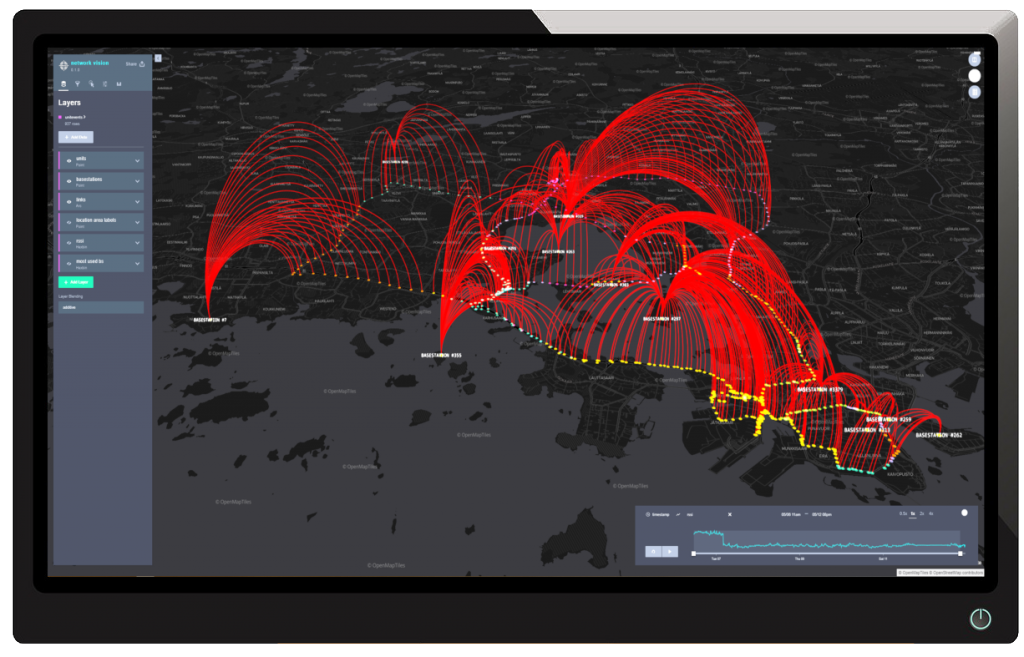USING CROWDSOURCING AND AI TO IMPROVE RELIABILITY OF THE CRITICAL NETWORK
Using crowdsourcing to measure the quality of the network, i.e. collecting service quality and customer experience data directly from end-user devices, is a quite commonly used approach in commercial mobile networks.
This is done by the mobile operators via their own over-the-top (OTT) apps, as well as by 3rd parties via dedicated apps or measurement components embedded in any OTT app.
As an outcome, realistic information about different location´s network coverage and service performance can be received, from an anonymous user perspective, and used in network planning and operator benchmarking.
In Critical Networks so far, this has not become a standard approach. This is mainly due to:
-
Technical limitations in PMR technologies and radios. There is no standard way of collecting network information from terminals, even if some devices support proprietary ways of doing so.
-
As the networks are typically dedicated, there are less users roaming around.
-
The nature of information might be sensitive, such as user’s location, so data is not easily shared between the network operator and user organisations.
On the other hand, the user organisations do have an interest in being able to verify the service quality in their own region. There is a clear benefit in systematic gathering of crowdsourced data also from critical networks.
Here comes the MOBILE BROADBAND
Critical Communications Technologies are evolving, but from the end-user perspective the basic criteria for communications service remains the same: It just needs to work every time. We predict that fulfilling that need will not become any simpler in the future.
While the networks are planned, built and validated to be resilient and reliable, problems still occur. Weather and natural forces cause physical damage to equipment, incidents happen at locations where capacity needs are not predicted, power outages take longer than the spare batteries last etc. Monitoring the services and systems and fixing the detected problems remain some of the key elements in operating any network, not to mention Critical Networks.
As the network is critical for the users, any problem may have serious consequences, especially if the timing is bad. This is often the case as the same phenomenon that caused the incidents the first responders are handling, is also causing a problem in the network.
While network management systems monitor alarms, key performance indicators and equipment statuses quite well, some problems are not visible in the NMS. Only the users will experience the problem. This is where crowdsourcing helps: detecting issues that only user´s equipment experience and seeing the real status of the network and detecting the subtle changes that may lead to problems later.
Combining the information collected from the network and users enables monitoring the network from multiple viewpoints, providing a holistic view of the service. Having this view in real-time gives operators the ability to correct problems immediately as they emerge or even act proactively solving problems before they impact the users. This is crucial when dealing with critical operations.
Which crowd can we source and how?
From a critical network operator’s and user organisation’s perspective, who we can monitor:
-
Our own field force. We know their needs. Understanding if they have all the critical services available is valuable.
-
Other agencies. Understanding who else is using the network and could agree to provide anonymous real-time network information to build a more holistic view of the network.
-
The public. If the service is relying on a commercial radio network.
Crowdsourcing data from PMR networks e.g. TETRA radios is possible. Some terminal vendors support protocols that can be used to collect information in real-time. This can be utilised to collect information from the field force and from other users of the network.
For LTE networks, the information is collected via OTT applications that are deployed to user devices.
If both PMR and mobile networks are used, which is often the case in critical communications, a unified view of what services are available in the field can be provided.
Introducing a new approach
In our approach, the crowdsourced data is collected systematically and constantly with a plan to generate a comprehensive baseline view of the network.
systematically and constantly with a plan to generate a comprehensive baseline view of the network.
Also, as part of the data collection, the user organisations can verify if any problems have appeared in their area and better collaborate with the network operator to address those issues as part of normal service process. Crowdsourcing provides users a tool to pinpoint the problem they are facing and have the evidence available to prove it.
We run the collected data through machine learning algorithms to establish a view of what “normal” looks like. This enables us to detect whenever something changes in the network i.e. network anomalies. Changes in network coverage, how handovers happen, network performance parameters in different locations and more can all be spotted in real-time.
Spotting an anomaly means that something MAY be in a way it’s not supposed to. The situation is quickly assessed to check if the anomaly indicates a problem or not. Getting an early indication of an issue in the network buys time and enables solving them before they impact the users.
Solving important problems before they become urgent can make all the difference when managing critical operations.
Jarno Taskinen
Head of Product Marketing